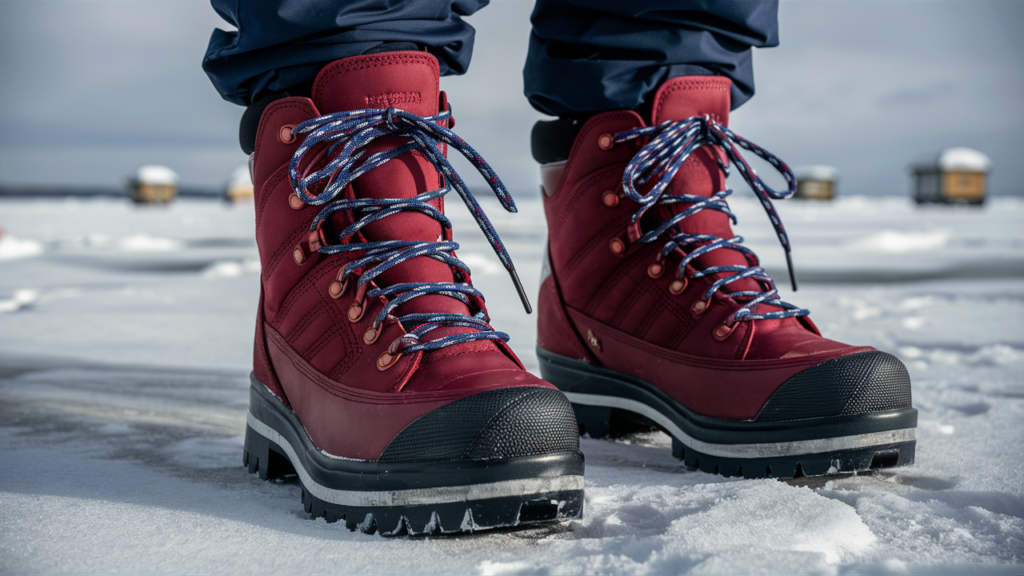Choose ice fishing boots that provide insulation, waterproofing, and traction. Ensure they fit well and allow for easy movement.
Recommended Best Ice Fishing Boots 2025
| Recommendation | Product |
| Best Overall | Baffin Men’s Snow Monster |
| Popular Choice | Columbia Men’s Bugaboot III Snow Boot |
| Best Value | MUCK Men’s Arctic Snow Boot |
| Best Budget | ALEADER Men’s Outdoor Snow Boots |
| Another Excellent Pick | NORTIV Waterproof Snow Boots |
Ice fishing combines the thrill of the catch with the chill of winter. Proper footwear is essential for comfort and safety on the ice. With temperatures often plummeting, selecting the right boots can make or break your fishing experience. Insulated and waterproof boots keep your feet warm and dry, preventing frostbite.
Traction is crucial to navigate slippery surfaces safely. The right fit ensures mobility, allowing you to focus on fishing rather than discomfort. This buying guide will help you understand key features to look for in ice fishing boots, ensuring you make an informed choice for your next outing on the frozen lake.
Essentials Of Ice Fishing Boots
Choosing the right ice fishing boots is crucial. They keep your feet warm and dry. Proper boots enhance your comfort and safety on the ice.
Key Features To Look For
- Insulation: Look for boots with thick insulation. This keeps your feet warm in freezing temperatures.
- Waterproofing: Ensure the boots are 100% waterproof. Wet feet can lead to frostbite.
- Traction: A good sole provides grip on slippery surfaces. Choose boots with rugged, slip-resistant soles.
- Height: Taller boots offer more coverage. They prevent snow and water from entering.
- Comfort: Cushioned insoles enhance comfort during long fishing trips.
Material Matters
The material of ice fishing boots affects performance and durability.
| Material | Benefits | Drawbacks |
|---|---|---|
| Leather | Durable and provides good insulation. | Can be heavy and less waterproof. |
| Synthetic | Lightweight and often waterproof. | May not provide as much warmth. |
| Neoprene | Excellent insulation and waterproofing. | Can be less breathable. |
Choosing the right material is vital. Each type offers unique benefits. Consider your fishing conditions before making a decision.
Thermal Insulation For Warmth
Choosing the right thermal insulation in ice fishing boots is vital. It keeps your feet warm in frigid temperatures. Warm feet help you enjoy your fishing experience. Different types of insulation offer various benefits. Understanding these types helps in making the best choice.
Types Of Insulation
Ice fishing boots feature several insulation types. Each type has unique advantages. Here’s a quick overview:
| Insulation Type | Material | Warmth Level |
|---|---|---|
| Thinsulate | Synthetic fiber | High |
| Neoprene | Rubber-like material | Moderate |
| Felt | Natural fibers | Good |
| Down | Natural bird feathers | Very High |
Each insulation type suits different conditions. Thinsulate provides excellent warmth without bulk. Neoprene offers water resistance but may lack warmth. Felt is great for dry cold conditions. Down insulation is warm but requires careful handling.
Balancing Warmth And Mobility
While warmth is crucial, mobility matters too. Heavy boots can hinder your movement. Lightweight options may sacrifice warmth. Finding the right balance is essential.
- Choose boots with flexible soles.
- Opt for lightweight insulation.
- Consider adjustable straps for a better fit.
Test boots by walking around. Ensure they allow for easy movement. Warmth and comfort lead to a successful fishing trip.
Waterproofing Techniques
Choosing the right waterproofing techniques is essential for ice fishing boots. Proper waterproofing keeps your feet dry and warm. Various technologies exist that enhance water resistance in boots.
Technologies In Waterproofing
Several advanced technologies help ensure your boots remain waterproof:
- Membrane Technology: This includes materials like Gore-Tex. They block water while allowing sweat to escape.
- Seam Sealing: Boots with sealed seams prevent water from entering. This technique is vital for complete waterproofing.
- Water-Repellent Treatments: Coatings applied to the exterior repel water. These treatments provide an extra layer of protection.
- Rubber Construction: Some boots use rubber to create a waterproof shell. Rubber is naturally resistant to water.
Importance Of Breathability
Breathability is just as important as waterproofing. It allows moisture to escape, preventing sweat buildup. Here’s why breathability matters:
- Comfort: Breathable boots keep feet dry and comfortable.
- Reduced Odor: Moisture can cause odors. Breathable materials help reduce this issue.
- Temperature Regulation: Breathability helps maintain a stable temperature in the boots.
Choose boots that balance waterproofing and breathability. This ensures your feet stay dry and comfortable during ice fishing trips.
Traction And Stability On Ice
Choosing the right ice fishing boots is crucial for safety. Good traction and stability prevent slips and falls. Ice can be very slippery, so focus on the boot’s design. A solid grip helps you move safely on icy surfaces.
Sole Design Considerations
The sole of the boot plays a vital role in traction. Look for soles made from durable rubber. They should provide a strong grip on ice. Here are key features to consider:
- Textured Patterns: Deep treads improve grip.
- Flexibility: Softer soles adapt to uneven surfaces.
- Thickness: Thicker soles offer better insulation.
Check if the sole is designed for ice. Some soles are specially crafted for icy conditions. They enhance stability and reduce the risk of falls.
Advanced Grip Technologies
Modern ice fishing boots often include advanced grip technologies. These features can make a significant difference:
| Technology | Description |
|---|---|
| Vibram® Soles | Provides superior traction on slick surfaces. |
| Studded Soles | Metal studs offer extra grip on ice. |
| Ice Traction Spikes | Removable spikes for customizable grip. |
Boots with these technologies help maintain stability. They allow you to walk confidently on ice. Always prioritize boots with reliable grip features for your safety.
Comfort And Fit
Finding the right ice fishing boots is crucial for comfort. The right fit helps keep your feet warm and dry. It also prevents blisters and discomfort. Focus on sizing and adjustable features for the best experience.
Sizing For Optimal Comfort
Choosing the right size is essential. Poorly sized boots can lead to pain and cold feet. Here are some tips for sizing:
- Measure your feet in the afternoon. Feet swell during the day.
- Wear thick socks while measuring. This helps simulate real conditions.
- Check the manufacturer’s sizing chart. Sizes may vary by brand.
- Consider width and arch support. Different feet have different needs.
Always try on boots before buying. Walk around in them to check comfort. Ensure there’s enough room for your toes. A snug fit around the heel is important.
Adjustable Features For A Better Fit
Many ice fishing boots come with adjustable features. These can enhance comfort and fit. Here are key features to look for:
| Feature | Benefit |
|---|---|
| Laces or Straps | Provides a customizable fit |
| Velcro Closures | Easy to adjust while wearing gloves |
| Insulated Liners | Can be removed for a better fit |
| Adjustable Calf Width | Accommodates different leg sizes |
Look for boots with adjustable features. They help ensure a snug fit. A good fit keeps warmth in and cold out.

Durability And Build Quality
Choosing the right ice fishing boots means focusing on durability and build quality. These factors ensure protection against harsh winter conditions. Quality boots last longer and keep your feet warm and dry.
Materials That Last
Ice fishing boots are made from various materials. Each material has unique properties that affect durability. Here are some common materials:
| Material | Features |
|---|---|
| Rubber | Waterproof, flexible, and resistant to cold. |
| Neoprene | Insulates well, lightweight, and provides comfort. |
| Nylon | Durable, lightweight, and quick-drying. |
| Leather | Long-lasting, breathable, and water-resistant. |
Choose materials based on your fishing conditions. Rubber boots are ideal for wet environments. Neoprene is great for cold weather. Nylon offers excellent versatility, while leather provides durability.
Construction For Harsh Conditions
Boot construction significantly impacts performance. Key construction features include:
- Sealed Seams: Prevents water entry.
- Insulation: Keeps feet warm in frigid temperatures.
- Tread Patterns: Provides traction on slippery surfaces.
- Height: Taller boots keep snow out.
Quality construction protects against the elements. Check for reinforced areas, especially around the toes and heels. Boots with thicker soles offer better insulation from cold surfaces.
Invest in boots built for the harshest conditions. A sturdy pair ensures comfort and safety during your ice fishing adventures.
Safety Features
Choosing the right ice fishing boots is crucial for safety. They should protect your feet from extreme cold and potential hazards. Look for boots with essential safety features to ensure a secure fishing experience.
Protective Elements
Ice fishing boots should have strong protective features. Consider the following elements:
- Insulation: Look for boots with thick insulation. This keeps your feet warm.
- Waterproofing: Choose waterproof materials. Wet feet can lead to frostbite.
- Reinforced Toes: Boots with reinforced toes protect against heavy objects.
- Slip-Resistant Soles: Ensure soles provide good traction. This prevents slips on ice.
Visibility In Low-light Conditions
Visibility is vital during early mornings or late evenings. Consider these features:
| Feature | Description |
|---|---|
| Reflective Strips: | Enhances visibility for others. |
| Bright Colors: | Choose boots in bright colors for better visibility. |
| LED Lights: | Some boots come with built-in lights. |
Prioritize safety features. They help you stay warm and visible. Enjoy your ice fishing adventure with confidence.
User Reviews And Recommendations
Buying the right ice fishing boots can be tough. User reviews provide real insights. They help you understand how boots perform in cold conditions. Recommendations from fellow anglers make the decision easier.
Leveraging Community Feedback
Community feedback offers valuable information. It highlights what others love or dislike about specific boots.
- Comfort: Many users emphasize comfort for long hours.
- Insulation: Warmth is a top priority in user reviews.
- Traction: Safety on ice is often mentioned.
- Waterproofing: Essential to keep feet dry.
Check online forums and social media. These platforms are goldmines for user experiences. Pay attention to repeated themes in reviews. They often reveal important details.
Top Picks From Experienced Anglers
Many seasoned anglers have their favorites. Here are some top recommendations:
| Boot Model | Key Features | User Ratings |
|---|---|---|
| Model A | Insulated, waterproof, lightweight | 4.8/5 |
| Model B | High traction, breathable, warm | 4.6/5 |
| Model C | Durable, adjustable fit, waterproof | 4.7/5 |
These models receive high praise from users. They are proven in various ice fishing conditions. Consider these options for your next purchase.
Care And Maintenance
Proper care and maintenance of your ice fishing boots ensure long-lasting performance. Follow these tips to keep your boots in top shape. This guide includes essential practices for extending their life and storing them correctly during the off-season.
Extending The Life Of Your Boots
To make your ice fishing boots last, follow these tips:
- Clean Regularly: Remove dirt and salt after each use.
- Dry Properly: Air-dry boots away from direct heat.
- Use Waterproofing Spray: Apply it periodically for added protection.
- Check for Damage: Inspect for cracks or tears before each trip.
These simple steps will keep your boots functional and comfortable.
Storage Tips For Off-season
Proper storage can prevent damage during the off-season. Consider these guidelines:
- Clean Before Storing: Remove dirt and moisture completely.
- Store in a Cool, Dry Place: Avoid humidity and extreme temperatures.
- Use Boot Trees: Maintain shape and prevent creasing.
- Avoid Heavy Weight: Do not stack heavy items on top.
Following these storage tips will help your boots stay in excellent condition. With proper care, your ice fishing boots will be ready for many adventures to come.
Budget Considerations
Buying ice fishing boots can be tricky. Finding the right balance between quality and cost is essential. This section will help you make smart choices. Understanding your budget can lead to better decisions.
Finding Value For Money
Value for money is key in any purchase. Here are some tips to find great boots without overspending:
- Research Brands: Some brands offer better quality at lower prices.
- Check Reviews: Look for customer feedback on durability and comfort.
- Compare Prices: Visit different stores and online shops for the best deals.
- Sales and Discounts: Keep an eye out for seasonal sales.
Price Vs. Performance
Understanding price versus performance helps you choose wisely. Here’s a simple breakdown:
| Price Range | Performance Level | Best For |
|---|---|---|
| Under $100 | Basic | Beginners or casual fishers |
| $100 – $200 | Mid-range | Regular fishers needing comfort |
| Over $200 | High performance | Serious anglers and extreme conditions |
Higher prices often mean better materials and features. Think about how often you will use the boots. Spending more upfront can save money in the long run.
Frequently Asked Questions
What Features Should I Look For In Ice Fishing Boots?
When choosing ice fishing boots, prioritize insulation, waterproofing, and traction. Insulation keeps your feet warm in frigid temperatures. Waterproof materials prevent moisture from seeping in. Additionally, a durable sole with good grip ensures stability on slippery surfaces. These features enhance comfort and safety during your ice fishing adventures.
How Do I Choose The Right Size For Ice Fishing Boots?
To choose the right size for ice fishing boots, consider wearing thicker socks. Measure your foot length and width accurately. Check the manufacturer’s size chart, as sizes can vary. Always try on boots before purchasing, ensuring enough room for movement and warmth.
A proper fit enhances comfort during long outings.
Are Insulated Boots Necessary For Ice Fishing?
Yes, insulated boots are crucial for ice fishing. They help maintain warmth in extremely cold conditions. Without proper insulation, your feet can become uncomfortably cold, leading to numbness. Insulated boots also provide better comfort and support, allowing you to enjoy your time on the ice without discomfort.
Can I Use Regular Winter Boots For Ice Fishing?
While regular winter boots offer some warmth, they may lack essential features for ice fishing. They often lack waterproofing and specialized traction, making them less effective on ice. Investing in dedicated ice fishing boots ensures better insulation, grip, and comfort.
This choice enhances your overall ice fishing experience significantly.
Conclusion
Choosing the right ice fishing boots is essential for comfort and safety. Prioritize insulation, waterproofing, and traction to enhance your experience on the ice. Remember to consider fit and style as well. With the right pair, you’ll enjoy countless days on the frozen lakes, making lasting memories.
Happy fishing!








